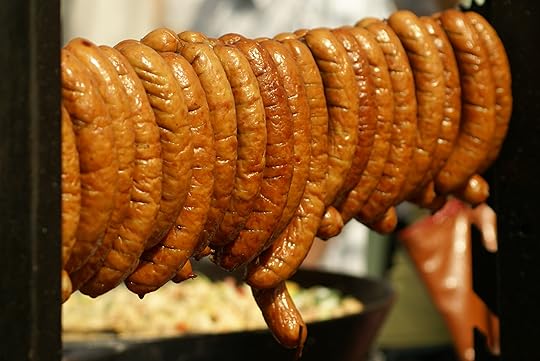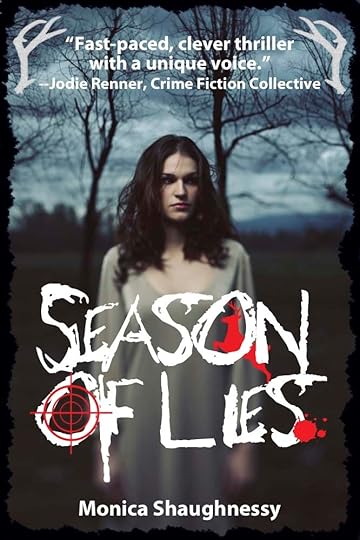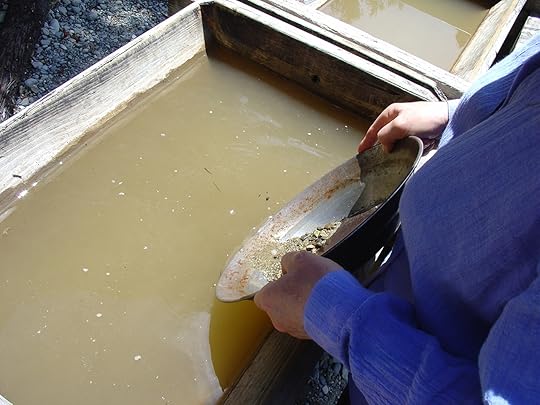Monica Shaughnessy's Blog, page 9
June 4, 2013
Cover Reveal: Doom & Gloom (middle grade book)
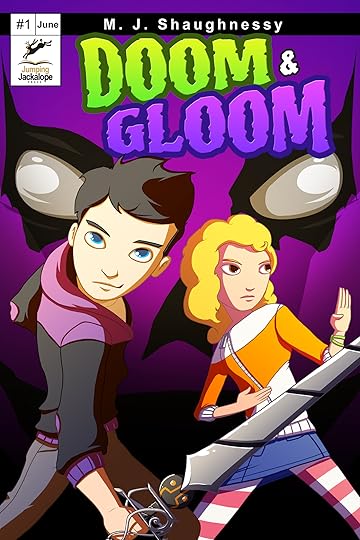 My new upper middle grade novel, Doom & Gloom, has been years in the making. I’ve taken characters out. I’ve added them. I’ve lowered the age of the protagonist. I’ve changed the plot–three times. It’s been beta read by a dozen people–including one awesome kid (shout-out to “Q”). And, er, some other business-y stuff I can’t talk about. But I wouldn’t have had the stomach to persevere if I didn’t feel strongly about this book.
My new upper middle grade novel, Doom & Gloom, has been years in the making. I’ve taken characters out. I’ve added them. I’ve lowered the age of the protagonist. I’ve changed the plot–three times. It’s been beta read by a dozen people–including one awesome kid (shout-out to “Q”). And, er, some other business-y stuff I can’t talk about. But I wouldn’t have had the stomach to persevere if I didn’t feel strongly about this book.
Synopsis: As the son of wealthy parents, twelve-year-old Dane Winter has everything a boy could want: a huge allowance, a private video arcade, and two robotic dogs at his command. Yet they’re no substitute for the one thing he can’t have–his freedom. Born with a rare sun allergy, Dane is unable to safely leave Winter Mansion by day until his parents give him a hi-tech solar suit for Christmas. But when he learns that the Mad Dog Gang plans to take over Winterville, Dane teams up with his klutzy gal pal, Jinx, and launches a superhero assault using his new gift. Full of sci-fi fun and dazzling sword-play, this book will appeal to action/adventure lovers, ages 10+.
I worked with artist, Kendrick Tu, to create the cover. He is professional, his rates are reasonable, and he met his deadlines. I highly recommend him.
The book should launch in a couple of weeks, provided I’m not crushed by my to-do list between now and then. When it does go live, it’s going to take weeks to wipe the smile from my face.
If you know of anyone who blogs about middle grade books or books for boys, I’d love to hear about them in the comments section.


May 14, 2013
Reaching for Fitzgerald: Futility Defined
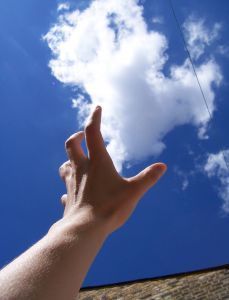 When I first read that a movie remake of The Great Gatsby was scheduled for release, I did the Snoopy happy dance. Throughout the next few weeks, trailers flitted past my screen during DVR fast-forwards, building my excitement. I made secret plans to sneak away during the day and watch the movie by myself. I wanted to experience the glory of Fitzgerald alone; I wanted space to revel in the flesh and blood version of his masterpiece.
When I first read that a movie remake of The Great Gatsby was scheduled for release, I did the Snoopy happy dance. Throughout the next few weeks, trailers flitted past my screen during DVR fast-forwards, building my excitement. I made secret plans to sneak away during the day and watch the movie by myself. I wanted to experience the glory of Fitzgerald alone; I wanted space to revel in the flesh and blood version of his masterpiece.
And then the reviews came out.
As you’ve heard by now, The Great Gatsby movie was released to mixed reviews. Hip hop music? Really? 3-D? Are you kidding me? Most of them compare the movie to a cinematic orgy–visually stimulating, but wholly unsatisfying. Was I pissed? Oh, yeah. Not because people didn’t like the movie, but because someone had reached for Fitzgerald and royally missed the mark. Then it hit me: no one who’s ever reached for Fitzgerald has hit the mark, and no one ever will. So I decided that if I truly wanted to revel in the masterpiece, I’d reread the darned book and leave it at that.
Some of you may not be Gatsby fans (gasp!). But I’m sure you’ve got your own favorite authors, be they classic or contemporary. And no fan fic/movie remake/stage play/You Tube skit of that person’s work could ever, ever match the original, am I right? The way an author strings words can never be equaled, and anyone attempting, by flattery or by trick, to replicate them is doomed to fail. But it goes deeper. To build an homage to greatness, one must also contend with an individual reader’s connection to the masterwork. Yeah. Good luck with that.
Since no article about Fitzgerald would be complete without his words, I give you this passage from the final page of the book:
“And as I sat there, brooding on the old unknown world, I thought of Gatsby’s wonder when he first picked out the green light at the end of Daisy’s dock. He had come a long way to this blue lawn and his dream must have seemed so close that he could hardly fail to grasp it. He did not know that it was already behind him, somewhere back in that vast obscurity beyond the city, where the dark fields of the republic rolled on under the night.”
So, too, is The Great Gatsby. It’s behind us, in the vast obscurity of literature, never to return again. But if you listen, you can still hear the book’s echo, vibrating across a century.


March 25, 2013
Book Marketing: What’s Working, What Ain’t
 I’ve been meaning to write this post for awhile now and share some of the things that have and haven’t worked for me on my (brand new!) self-publishing journey. When I began (about four and a half months ago), I published two YA books at once, but took very different tracks with them. You can read about that here.
I’ve been meaning to write this post for awhile now and share some of the things that have and haven’t worked for me on my (brand new!) self-publishing journey. When I began (about four and a half months ago), I published two YA books at once, but took very different tracks with them. You can read about that here.
To level set, both books were professionally edited. So the interior quality is the same. The variances (or so I thought) were in marketing approach and, potentially, cover design.
On to the results…
Season of Lies:
I went the fat ticket route with this one, throwing a bunch of money into the marketing, and I signed up for KDP Select.
I started off with Book Rooster, and hoped that readers would review my book before my free days. Might entice more people to download, I reasoned. Well, by the time my promotion rolled around (almost six weeks later), I still only had four or five reviews out of the ten I was promised. As of this writing, I’ve still only received eight of the ten (again, four and a half months later). But, I will say that most of the reviews were very complimentary and really made my day. And lest anyone think they were fake reviews, think again. I also got a few “didn’t like it” reviews from the same company. So they’re offering unbiased comments. You have to take the good with the bad.
I then turned to various book bloggers to review my book. I got a few people who said they’d put it in their TBR pile, but that this was no guarantee of a read. I got a bunch of people who didn’t bother to reply. And I got one review from Yawatta Hosby. Super sweet person. She and I met through this blog. If you’re an indie author, she does reviews for quite a few people.
Next, I paid for a Kindle Nation email sponsorship for my first free promotion and watched my downloads spiral upward. My numbers weren’t stellar, but they impressed me, earning me the number one spot in my genre and #263 in the overall store. Two days later, I got that coveted bounce. When the dust settled, I basically covered the cost of my sponsorship. So it was a wash. And if you know how much the sponsorships cost, you know I didn’t make gobs of money. On the upside, the guy who runs Kindle Nation was a joy to work with.
The second time I did my free promotion, I was feeling rather miserly and decided to promote using only free outlets. Of course I tried Pixel of Ink (can you hear me laughing?) and then turned to Indie View and Big Al’s Books and Pals. They featured me in an interview and listed my promotion on their blog. I can’t say enough nice things about Big Al. He’s doing so much to promote indie authors and if you haven’t checked out his websites, do so now. With that, I saw almost as many downloads and my ranking shot up almost as high as with my first promotion–almost being the key word. I think I gained the #2 position in my genre, but hovered around the 500 to 600 range in the store. And that, my friends, delivered no bounce. Ouch. At least I wasn’t out any money. Post promotion, the book dropped back into a black hole where it lives today, peeking out only occasionally.
Would I buy a Kindle Nation sponsorship again? Maybe. But only if I had something squarely in an adult genre.
Would I hire Book Rooster again? Maybe. But only if I had a book that couldn’t get any reviews after several months. If someone else has had a different experience with them, I’d love to hear about it.
Would I try to find book reviewers? Yes, but only if they’re known for reviewing indie books or I had an “in” with them. Otherwise, it’s a time suck that delivers very little on the backend.
Now on to the second book…still with me?
Universal Forces:
I went the “release it and forget it” route with this one, though I did contact a few book reviewers. I also didn’t sign up for KDP Select. Instead, I chose to release my book onto Barnes & Noble and Kobo as well.
Two things came of my book review submissions. Someone from Big Al’s website decided to do a review (after I reached out to them for a Season of Lies interview) and another book blogger confirmed he’d blog about my book in April.
Other than those two bright spots, the book languished on the Amazon charts, collected very few customer reviews, and saw very few sales. And I sold zero–z-e-r-o–copies on B&N and Kobo. Blech. Clearly, the “release it and forget it” path, the path of least resistance, didn’t work for me.
This prompted me to sign Universal Forces up for KDP Select, re-do my cover, do another free promotion, and use the services of ebookbooster. I went for broke and used all five days at once. Even though I reached and stayed at the number one spot in my genre for nearly the whole time, I only gave away a few hundred books and never climbed any higher than #2,500 (or thereabouts) in the store. And there was no bounce. NO BOUNCE, I tell you! Arghhhhh!
Would I sign up for KDP Select Again? Yes, but only as a marketing tool to “hook” my book into the store. In the future, I will have absolutely no expectation of making money post-promotion and will not likely spend any money to announce it (unless it’s free or cheap, like ebookbooster). I also wouldn’t schedule all five days at once. I’d schedule two days–max–and wait. If I’m gaining on the second day, I’ll add another promotion day. If I’m winding down, I’ll save the rest of the days for a second promotion.
I read on another blog that unless you’ve already achieved a high ranking in the store, it’s useless to do a free promotion because you’re not likely to see any meaningful boost in sales afterwards. I now completely concur. Though it’s a catch-22, isn’t it? How can you achieve a high ranking if you don’t do any promotions? Maybe it happens organically for some, but it hasn’t for me.
So why did one book (sort of) succeed with the free promotion and the other fizzle? The only thing I can think is that Season of Lies is more of a crossover title and Universal Forces is straight-up YA. When thumbing through the “customers who bought your book also bought…” listings, it was clear that adults were buying Season of Lies and teens (or big fans of teen literature) were buying Universal Forces. This leads me to believe that adult readers pay attention to things like Kindle Nation and free book sites and teens are relying mostly on word of mouth for what to read. I have very little data to back this up. Mostly just a hunch, but it’s pretty strong.
My final take-away? I’ve got to do something to promote my books. The “release it and forget it” model just doesn’t work. At least not for me.
Are there people uploading bizarre stream-of-conscious novellas about the fluttery qualities of Sonic Ice, complete with hand-drawn book covers, who are selling the crap out of their stuff with absolutely no effort? Yeah. Makes me want to write one. But until I do, I’m stuck doing things the hard way. And waiting for my luck to kick in.
In the meantime, I’m working on a new project in an adult genre. One that I’ll be releasing under a pen name. The results should be interesting!
————————————->
Anyone else out there have experience with the vendors I used? Anyone else out there have marketing techniques that worked for them? I’d love to hear about them.


March 21, 2013
The Twelve-Step Program for Writers
 Writing has turned me a little manic lately, so I thought I’d indulge in some self-help.
Writing has turned me a little manic lately, so I thought I’d indulge in some self-help.
1. We admitted we were powerless over writing – that our writing had become an unmanageable time suck.
2. Came to believe that a Power greater than ourselves could restore us to sanity after failing to find an editor, an agent, a juicy book deal, a starred review in Publishers’ Weekly, intergalactic sales numbers. (choose your own obsession)
3. Made a decision to turn our career over to the whims of Fate, Luck, and the Amazon Algorithm.
4. Made a searching and fearless moral inventory of our writing skills and then hid in the closet with a bag of Oreos.
5. Admitted to our families, to ourselves, and to our critique group the exact nature of our writing wrongs.
6. Were entirely ready to remove all these defects of characterization and plot (after some swearing and crying).
7. Humbly asked them to remove our shortcomings with the stroke of a red pen.
8. Made a list of all beta readers we had harmed with lousy stories, and became willing to make amends to them all.
9. Made direct amends to such readers wherever possible, except when to do so would cause them to remember our awful prose.
10. Continued to take personal inventory of our writing skills, and when we sucked, promptly admitted it.
11. Sought through conferences and workshops to improve our industry connections.
12. Having had a creative awakening as the result of these steps, we tried to carry this message to other writers and tried to write another book again.


January 11, 2013
A Confession
 I have a confession to make: my YA novel, Season of Lies, has a fake review on Amazon. It was created by someone who didn’t read the book and was posted for the sole purpose of making me look good. And I couldn’t be prouder to admit it.
I have a confession to make: my YA novel, Season of Lies, has a fake review on Amazon. It was created by someone who didn’t read the book and was posted for the sole purpose of making me look good. And I couldn’t be prouder to admit it.
That review, folks, was from my daughter.
As a grade-schooler, she isn’t allowed to read mommy’s “older stuff.” But, without my knowledge, she spent her hard-earned money, I repeat, her own money, to buy my books (both of them). As anyone knows, kids are pretty stingy with their allowance, especially when what they receive on a weekly basis barely amounts to a couple of lattes at Starbucks. She then left the following comment, again, without my knowledge, which you can read here. Yes, it’s a bit over the top, but it means the world to me.
You see, I’ve been at this business of writing for years with precious little to show for it. Sure, I’ve got a few items in the win column, but overall, I’m sitting on the runway, waiting for take-off. My family has watched me go through all of it: hundreds of rejections letters from editors and agents, crushing critiques, gut-wrenching near-misses, failed contracts, conference leads that turn to dust, and the numbing ambivalence that pervades the industry. Let’s face it, writing is one of the few professions where you can do everything right and still fail.
I used to fall asleep every night with a clear vision of waking up to a six-figure deal. A few years later, this dream was replaced by a more down-to-earth one in which I received a modest, but fair contract from a small publisher. More recently, I envisioned building a self-published empire. Now? I turn out the lights, shut my eyes, and fall asleep. I still may build that empire or snag that contract, but I no longer dream of the day when that will happen. I can’t. I’ve wasted too many on such pursuits.
My pessimistic side wonders if I’ll ever gain success (my version of it) when both sides of the street are equally perilous. Self-publishing is a flat-out popularity contest, where good writing takes a back seat to stump thumping, and traditional publishing is collapsing into a smaller, tighter singularity, where breaking in will be that much harder.
Then my daughter plunks down $3.99 for my book and leaves a glowing review for the world to see, a review that lets me know how proud she is of me. This, this is enough to raise my optimism and keep me going for just one. more. day.


December 20, 2012
Artisanal Publishing
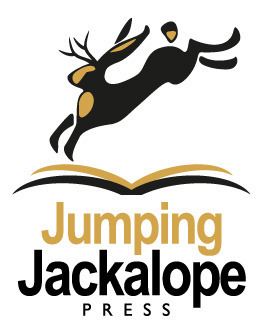 First: I want to let you know that my YA thriller, Season of Lies, is FREE to download today and tomorrow (Dec. 20 & 21). It’s actually #1 (last I checked) in the Teen Mystery & Thriller Kindle store. Yipee!
First: I want to let you know that my YA thriller, Season of Lies, is FREE to download today and tomorrow (Dec. 20 & 21). It’s actually #1 (last I checked) in the Teen Mystery & Thriller Kindle store. Yipee!
Now! On to my post.
I recently bought Guy Kawasaki’s APE (Author Publisher Entrepreneur), and so far, it’s worth every penny of the $9.99 I paid for it because the book supports something I’ve been mulling over awhile: the idea of artisanal publishing.
Think about it.
It happened with music: indie bands are the darlings of the music scene and provide a thriving sub-culture in many cities
It happened with art: local jewelry makers and knitters and painters set up their own stores on websites like Etsy
It happened with food: craft beer, small-batch bakery items, hand-made cheese. Need I say more?
It happened with restaurants: you don’t need hundreds of thousands of dollars to open a restaurant, you just need a food truck and a parking permit
And soon, it will happen with indie books (if it’s not happening already).
Yes, yes, we’re in the middle of an indie publishing revolution. But I’m not talking about that. I’m talking about what’s next. I’m talking about creating quality books that reflect the author’s personality and offering them up in a stylish and entertaining way with real niche-appeal. Some writers are doing this now – the good ones, the savvy ones – but they’re in the minority. So many self-published books still look self-published (though they’re getting better), and they’re supported by only a flimsy Twitter account.
“Ha!” you scoff, “all I have to do is write a good book.” (you did scoff, didn’t you?)
Here’s the problem. Everyone else wrote a good book, too. I just flipped over to Amazon and did a search on “ebooks.” Amazon returned 5,547,840 results. Ouch. And I know someone out there will maintain that they don’t do it for the sales. That’s cool. Keep on keepin’ on. But even if it’s not about the money, it’s still about getting read, right?
Any-hoo. To boost myself over that impenetrable wall, I’ve created a new website, Jumping Jackalope Press, that’s going to house all of my different self-published genres as well as offer (in the future) entertaining content that reflects my sensibilities. It will also provide a more professional face to the reader and has an “artisanal” feel to it. Will it be successful? Only time will tell.
Here’s what I do know: after navigating the self-publishing waters these last few weeks, most of the info that I gathered last year on the “must do’s” is terribly out of date and completely overdone. I’m finding more and more that I need to strike out on the path less taken.
————————————–>
Anyone else pick up Guy Kawasaki’s book? What are your thoughts on “artisanal publishing”? Is this just marketing spin? Or is it a sound business strategy? Know of any authors who meet this model?


November 27, 2012
Making the Sausage
There’s an old saying: once you see how the sausage is made, you don’t want to eat the sausage. And from my own experience, I know it’s true. Once I learned how to make a book, I became pickier about what lay between its covers.
I was never a book-a-day kinda gal, but in my pre-writing days, I could easily go through two or three a month. Sure, I slowed down when work and family took priority. But even when I didn’t have the time to read, I longed to read. Now that I’ve written dozens of books myself? Not so much. Don’t get me wrong. I still have a passion for literature. It’s just that finding a novel I want to devote several hours of my life to has become a difficult task.
Each of my manuscripts has been labored over, ad infinitum: the plot, the character arcs, the “emotional heart,” the theme, how many semicolons I can get away with…you get the idea. And then there’s the revision process where you’re ready to drive your car into a swamp if you have to “examine the story” one. more. time. So! If I pull a book off the library shelf and it doesn’t open right or the plot is sluggish or the characterization strains credibility, I want to throw it (or my e-reader) across the room. Partly because I either wasted money buying it or an hour at the library picking it out, partly because I’m amazed that big publishers are capable of offering marginally written fare. Alert: I’m not one of “those” writers who thinks everything the Big Six puts out is crap. On the contrary. But they have put out a few books that should have been edited with a heavier hand.
And now that I’ve self-published, I know even more about the sausage, er, book-making process. The formatting, the book covers, the ISBNs, the stupid table of contents that works in one store but not another…and don’t get me started on Apple ibooks–a nightmare maze of “contracts” and weird hoops to jump through and apps to download. Cripes, what is it with Apple and downloadable apps? Can’t they make one flippin’ thing that’s web-based? I digress… Bottom line: All this book business has given me a giant literary headache. And I don’t think “take two novels and call me in the morning” is going to work.
I took a screenwriting class eons ago where we learned about the three-act structure. The teacher told us that once we understood the “beats” of the story, we’d never be able to watch another movie like a “normal person” again, with abandon, with wonder, with wide-eyed amazement. We’d begin to see the sausage maker at work behind the story. So true with books.
————————————>
Anyone else go through a time of disillusionment with books? I’d love to hear about it, if only to find out I’m not alone.


November 5, 2012
A Tale of Two Book Launches
Just last week, I self-published two of my YA titles. Even though my agent worked her tail off, the books failed to find an editor who believed in them enough. In reading the various rejections, my writing was always lauded. But it’s so much easier to say no than it is to say yes, especially to an author with a Twitter following of less than a hundred thousand. Ahem, make that a thousand. Have I given up on trad publishing? No. I’d love to be a hybrid author one day. However! This post isn’t about my decision to self-publish these two books. It’s about the two different promotional paths I outlined for them.
Which approach is going to work best? Beats me.
The first book, Season of Lies, is a YA thriller. For this title, I decided to go the fat-money, straight-ticket Amazon route and signed up for KDP Select. I’ve got my free days scheduled for December, plan on alerting Pixel of Ink, and purchased (oh, yes I did) a sponsorship on Kindle Nation–one of the cheaper sponsorships, but I still forked out dough. I also paid Book Rooster to get the ball rolling on my reviews. Hopefully, I’ll have some decent reviews by the time my free days kick in.
Season of Lies: Suspected of her brother’s murder, seventeen-year-old Robin Calloway uses her unique senses to track down the killer and unravel a lifetime of lies.
Moving on…
The second book, Universal Forces, is a YA romantic thriller. For this title, I’m going the lean-money, spread-it-around route. It’s on Amazon today, but I plan on uploading it to B&N, Apple, Kobo, etc. I’m also thinking about allromancebooks.com (love to know if anyone’s worked with them before). And once I get a few reviews, I hope to be in touch with a few local library systems. As for reviews, I’m contacting book reviewers and bloggers individually to see if they’ll feature my book. Ultimately, I’m going to try not to spend any money on promotions–at least during this intro period.
Universal Forces: In a modern day spin on Romeo and Juliet, Cassie and Jake battle forces that threaten to tear them apart when the Houses of Science and Religion clash.
I know, I know. The results of my little “marketing study” will be skewed by the fact that I’m using two different books. But they’re both YA, and they’re both thrillers and they’re both releasing at the same time. And it’s the best I’ve got.
At the end of the day, I’m left with the sense that I need to play just as many games to succeed in indie publishing as I ever did with traditional publishing. (a good subject for another post). This, unfortunately, is not a good feeling. As an ex-marketing manager, I’m used to basing my success on the quality of the product I’m offering and the level of satisfaction I bring my customers, not how many “tricks” I can employ on “just the right days.” It’s enough to make me scream.
Any-who, once I gather enough data, I’ll post another entry on the results.
——————————————>
If anyone out there has a blog I can guest post on, I’d love to stop by and promote my book. Also, I’m in the market for free advice right now re: promotions (what worked, what didn’t). Love to hear from you!


October 1, 2012
Anatomy of a Gold Rush: Reinventing Ourselves in the New eBook Economy
Soon, hopefully this week, I’ll be taking the self-publishing plunge that so many have taken before me, and I’m nervous.
Some very high-profile people have said time and again that the ebook boom isn’t a gold rush. But recently, I’ve been struck by the collective melancholy in the comments sections of the writing blogs I read. Around 60 to 70% report the same thing: everyone was doing “really well” last year…this year, not so much. And this, on the eve of my venture. Oh, boy.
Thinking I was being paranoid about the whole “gold rush” thing, I did some digging and learned about the life cycle of said gold rush. Double oh, boy. Too close to the present situation for my liking.
Stage One: Gold Panning – This required almost no expertise or cash outlay. All you had to do was hold your pan in a river and you got rich. Can’t tell you how many articles I read in 2010 where someone put up a book with a poorly designed cover and awful prose for .99 cents and made a gazillion dollars without any further effort. And remember all those people who started pet blogs or cooking blogs or cooking with pets blogs who got six-figure book deals? Yeah, me too. Good times. A few of these deals still happen, but they’re rare.
Stage Two: Opportunists Arise – In this stage, all of the people who thought they could get rich off the miners began selling pick axes, pans, and other gear (not to mention some nifty Levis). Remind you of anything? Book cover designers, freelance editors, formatters, PR and marketing firms, pop-up epublishers, etc., etc. Now, some of these people offer reputable and valuable services. I’ve used them myself. But some offer less than quality services to the unsuspecting or are out-and-out scams. Writer beware.
Stage Three: Placer Mining – Once the gold became harder to find in the streams, more equipment was needed to extract it, requiring more money and bigger organizations. Days of the individual miner were over. Smaller claims were bundled together into tracts that were sold off to large companies. Are we headed for this? Publishers like Penguin have already staked their claim by purchasing Author Solutions, a big, juicy tract of self-published writers all wrapped up with a bow.
Stage Four: Hard Rock Mining – Only deeply embedded gold is left and only large corporations with enough money to invest are able to capitalize during this stage. I don’t even have to draw a parallel here, do I? We’ve not arrived yet, but is this coming? Is this our future?
And where am I in all this? Running up an empty stream bed with my sluice box, shouting, “Wait for me! Wait for me!” Oy.
But I’m not one to wallow for long. So I did some more digging, er, mining, and I discovered that when the individual miners–the ones who were serious about it–couldn’t find any more gold, they sold their claims and moved on to silver mining, which led to copper mining, which led to zinc mining, which led to retirement. In other words, when one type of mining became unprofitable, they changed their strategy and switched to another type. The miners who weren’t serious about it went back to their day jobs tending bar at TGIFriday.
Thoughts on succeeding in the near future:
–Stay Adaptable. I’m not advocating schizophrenic writing, but I am advocating nimble writing. Assess the industry, assess your sales, assess the rising markets, and MEET THEM. If your cozy mysteries aren’t selling, write a hard-boiled detective novel.
–Become Content Focused. Even the president of Hachette said it himself in a recent Publishers Weekly article, “The industry is now content-centric, not format-centric.” Don’t forget, you’re not writing a book, you’re writing a story. Where/how else can it be distributed? At least two people got book deals by posting their book on Twitter and Facebook back when these sites were the hot new things in social media. Stay at the frontier of technology. I can’t say this enough.
–Create a Quality Product. This means you’ll have to spend a little money. Buy that Amazon ad. Pay for that cover. Hire that editor. The days of falling down face-first in the stream and landing on a gold nugget are over, my friends. You have to put in more work and more money to mine the gold. That’s reality.
Maybe the current ebook boom is a gold rush. But does that mean someone won’t strike a vein of another precious metal somewhere else and lead the market? Opportunities abound, they just might not be the SAME opportunities as last year. I’ll go even further and state that the smart writer of the future will be the one who creates a demand for their own precious commodities: voice and style. These are something that no one can claim jump.
————————————->
Any words of advice on self-publishing would be greatly appreciated. And if anyone wants to offer evidence that 2012 has been a rockstar year for them, I’d love to hear about that, too. I could use some good news!



